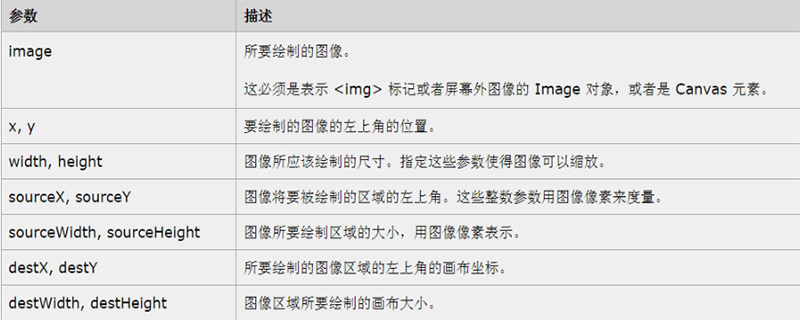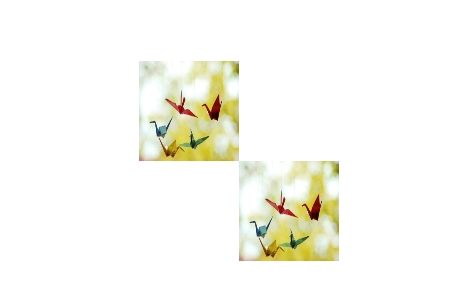 Web Front-end
Web Front-end
 HTML Tutorial
HTML Tutorial
 What are the methods for drawing images using the drawImage function?
What are the methods for drawing images using the drawImage function?
What are the methods for drawing images using the drawImage function?
drawImage function There are three ways to draw pictures: drawing according to the size of the original picture, drawing according to the specified size, and general methods can generally be used for picture cropping
Today we will introduce the drawImage function in canvas The usage has a certain reference effect, I hope it will be helpful to everyone

[Recommended course: HTML5 tutorial]
The drawImage function is a method in the canvas tag, a new element in HTML5. It is mainly used for drawing, synthesizing images, or doing simple animations, etc.
drawImage() There are three methods to achieve the effect of drawing
Method one:
The first method is to copy the entire image to the canvas and place it at the specified point and maps each image pixel to a unit of the canvas coordinate system. It will be drawn according to the size of the original image
drawImage(image, x, y)
Example: Draw the image on the canvas relative to the position of the upper left corner
<script>
var myImage=document.getElementById("myCanvas");
var cxt=myImage.getContext("2d");
var img=new Image();
img.src="images/22.jpg";
img.onload=function(){
cxt.drawImage(img,150,150);
cxt.drawImage(img,250,250);
}
</script>Rendering:

Method 2:
Although the second method also copies the entire image to the canvas, it allows us Specify the desired width and height of the image in canvas units.
drawImage(image, x, y, width, height)
Example: Set the size of the image
<script>
var myImage=document.getElementById("myCanvas");
var cxt=myImage.getContext("2d");
var img=new Image();
img.src="images/22.jpg";
img.onload=function(){
cxt.drawImage(img,150,150,100,100);
cxt.drawImage(img,250,250,100,100);
}
</script>Rendering:

Method three:
The third method is completely universal, it allows us to specify any rectangular area of the image and copy it, as well as perform any scaling to any position in the canvas
drawImage(image, sourceX, sourceY, sourceWidth, sourceHeight, destX, destY, destWidth, destHeight)
Example: Crop the picture
<script>
var myImage=document.getElementById("myCanvas");
var cxt=myImage.getContext("2d");
var img=new Image();
img.src="images/22.jpg";
img.onload=function(){
cxt.drawImage(img,20,30,50,50,25,25,100,100);
cxt.drawImage(img,115,115,100,100,125,125,200,200);
}
</script>Rendering:

Summary: The above is the drawImage function I hope this article can help you learn how to use the drawImage function.
The above is the detailed content of What are the methods for drawing images using the drawImage function?. For more information, please follow other related articles on the PHP Chinese website!

Hot AI Tools

Undresser.AI Undress
AI-powered app for creating realistic nude photos

AI Clothes Remover
Online AI tool for removing clothes from photos.

Undress AI Tool
Undress images for free

Clothoff.io
AI clothes remover

AI Hentai Generator
Generate AI Hentai for free.

Hot Article

Hot Tools

Notepad++7.3.1
Easy-to-use and free code editor

SublimeText3 Chinese version
Chinese version, very easy to use

Zend Studio 13.0.1
Powerful PHP integrated development environment

Dreamweaver CS6
Visual web development tools

SublimeText3 Mac version
God-level code editing software (SublimeText3)

Hot Topics
 1386
1386
 52
52
 What is the purpose of the <progress> element?
Mar 21, 2025 pm 12:34 PM
What is the purpose of the <progress> element?
Mar 21, 2025 pm 12:34 PM
The article discusses the HTML <progress> element, its purpose, styling, and differences from the <meter> element. The main focus is on using <progress> for task completion and <meter> for stati
 Is HTML easy to learn for beginners?
Apr 07, 2025 am 12:11 AM
Is HTML easy to learn for beginners?
Apr 07, 2025 am 12:11 AM
HTML is suitable for beginners because it is simple and easy to learn and can quickly see results. 1) The learning curve of HTML is smooth and easy to get started. 2) Just master the basic tags to start creating web pages. 3) High flexibility and can be used in combination with CSS and JavaScript. 4) Rich learning resources and modern tools support the learning process.
 What is the purpose of the <datalist> element?
Mar 21, 2025 pm 12:33 PM
What is the purpose of the <datalist> element?
Mar 21, 2025 pm 12:33 PM
The article discusses the HTML <datalist> element, which enhances forms by providing autocomplete suggestions, improving user experience and reducing errors.Character count: 159
 What is the purpose of the <meter> element?
Mar 21, 2025 pm 12:35 PM
What is the purpose of the <meter> element?
Mar 21, 2025 pm 12:35 PM
The article discusses the HTML <meter> element, used for displaying scalar or fractional values within a range, and its common applications in web development. It differentiates <meter> from <progress> and ex
 What is the viewport meta tag? Why is it important for responsive design?
Mar 20, 2025 pm 05:56 PM
What is the viewport meta tag? Why is it important for responsive design?
Mar 20, 2025 pm 05:56 PM
The article discusses the viewport meta tag, essential for responsive web design on mobile devices. It explains how proper use ensures optimal content scaling and user interaction, while misuse can lead to design and accessibility issues.
 What is the purpose of the <iframe> tag? What are the security considerations when using it?
Mar 20, 2025 pm 06:05 PM
What is the purpose of the <iframe> tag? What are the security considerations when using it?
Mar 20, 2025 pm 06:05 PM
The article discusses the <iframe> tag's purpose in embedding external content into webpages, its common uses, security risks, and alternatives like object tags and APIs.
 The Roles of HTML, CSS, and JavaScript: Core Responsibilities
Apr 08, 2025 pm 07:05 PM
The Roles of HTML, CSS, and JavaScript: Core Responsibilities
Apr 08, 2025 pm 07:05 PM
HTML defines the web structure, CSS is responsible for style and layout, and JavaScript gives dynamic interaction. The three perform their duties in web development and jointly build a colorful website.
 What is an example of a starting tag in HTML?
Apr 06, 2025 am 12:04 AM
What is an example of a starting tag in HTML?
Apr 06, 2025 am 12:04 AM
AnexampleofastartingtaginHTMLis,whichbeginsaparagraph.StartingtagsareessentialinHTMLastheyinitiateelements,definetheirtypes,andarecrucialforstructuringwebpagesandconstructingtheDOM.



